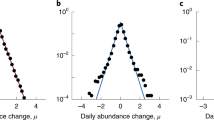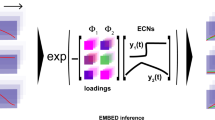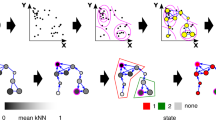Abstract
All animals studied to date are associated with symbiotic communities of microorganisms. These animal microbiotas often play important roles in normal physiological function and susceptibility to disease; predicting their responses to perturbation represents an essential challenge for microbiology. Most studies of microbiome dynamics test for patterns in which perturbation shifts animal microbiomes from a healthy to a dysbiotic stable state. Here, we consider a complementary alternative: that the microbiological changes induced by many perturbations are stochastic, and therefore lead to transitions from stable to unstable community states. The result is an ‘Anna Karenina principle’ for animal microbiomes, in which dysbiotic individuals vary more in microbial community composition than healthy individuals—paralleling Leo Tolstoy's dictum that “all happy families look alike; each unhappy family is unhappy in its own way”. We argue that Anna Karenina effects are a common and important response of animal microbiomes to stressors that reduce the ability of the host or its microbiome to regulate community composition. Patterns consistent with Anna Karenina effects have been found in systems ranging from the surface of threatened corals exposed to above-average temperatures, to the lungs of patients suffering from HIV/AIDs. However, despite their apparent ubiquity, these patterns are easily missed or discarded by some common workflows, and therefore probably underreported. Now that a substantial body of research has established the existence of these patterns in diverse systems, rigorous testing, intensive time-series datasets and improved stochastic modelling will help to explore their importance for topics ranging from personalized medicine to theories of the evolution of host–microorganism symbioses.
This is a preview of subscription content, access via your institution
Access options
Access Nature and 54 other Nature Portfolio journals
Get Nature+, our best-value online-access subscription
$29.99 / 30 days
cancel any time
Subscribe to this journal
Receive 12 digital issues and online access to articles
$119.00 per year
only $9.92 per issue
Buy this article
- Purchase on Springer Link
- Instant access to full article PDF
Prices may be subject to local taxes which are calculated during checkout


Similar content being viewed by others
References
McFall-Ngai, M. et al. Animals in a bacterial world, a new imperative for the life sciences. Proc. Natl Acad. Sci. USA 110, 3229–3236 (2013).
Pace, N. R. A molecular view of microbial diversity and the biosphere. Science 276, 734–740 (1997).
Hug, L. A. et al. A new view of the tree of life. Nat. Microbiol. 1, 16048 (2016).
Konstantinidis, K. T. & Tiedje, J. M. Towards a genome-based taxonomy for prokaryotes. J. Bacteriol. 187, 6258–6264 (2005).
Chaffron, S., Rehrauer, H., Pernthaler, J. & von Mering, C. A global network of coexisting microorganisms from environmental and whole-genome sequence data. Genome Res. 20, 947–959 (2010).
Zaneveld, J. R., Lozupone, C., Gordon, J. I. & Knight, R. Ribosomal RNA diversity predicts genome diversity in gut bacteria and their relatives. Nucleic Acids Res. 38, 3869–3879 (2010).
Langille, M. G. I. et al. Predictive functional profiling of microbial communities using 16S rRNA marker gene sequences. Nat. Biotechnol. 31, 814–821 (2013).
Rinke, C. et al. Insights into the phylogeny and coding potential of microbial dark matter. Nature 499, 431–437 (2013).
Frost, L. S., Leplae, R., Summers, A. O. & Toussaint, A. Mobile genetic elements: the agents of open source evolution. Nat. Rev. Microbiol. 3, 722–732 (2005).
Sachs, J. L., Skophammer, R. G. & Regus, J. U. Evolutionary transitions in bacterial symbiosis. Proc. Natl Acad. Sci. USA 108, 10800–10807 (2011).
Sharon, G. et al. Commensal bacteria play a role in mating preference of Drosophila melanogaster. Proc. Natl Acad. Sci. USA 107, 20051–20056 (2010).
Hsiao, E. Y. et al. Microbiota modulate behavioral and physiological abnormalities associated with neurodevelopmental disorders. Cell 155, 1451–1463 (2013).
Nyholm, S. V. & McFall-Ngai, M. The winnowing: establishing the squid–vibrio symbiosis. Nat. Rev. Microbiol. 2, 632–642 (2004).
Coppa, G. V., Bruni, S., Morelli, L., Soldi, S. & Gabrielli, O. The first prebiotics in humans: human milk oligosaccharides. J. Clin. Gastroenterol. 38, 80–83 (2004).
Flórez, L. V., Biedermann, P. H. W., Engl, T. & Kaltenpoth, M. Defensive symbioses of animals with prokaryotic and eukaryotic microorganisms. Nat. Prod. Rep. 32, 904–936 (2015).
Ellner, S. P., Schluter, J. & Foster, K. R. The evolution of mutualism in gut microbiota via host epithelial selection. PLoS Biol. 10, e1001424 (2012).
Barr, J. J. et al. Bacteriophage adhering to mucus provide a non-host-derived immunity. Proc. Natl Acad. Sci. USA 110, 10771–10776 (2013).
Whittaker, R. H. Evolution and measurement of species diversity. Taxon 21, 213 (1972).
Turnbaugh, P. J. et al. A core gut microbiome in obese and lean twins. Nature 457, 480–484 (2008).
Jani, A. J. & Briggs, C. J. The pathogen Batrachochytrium dendrobatidis disturbs the frog skin microbiome during a natural epidemic and experimental infection. Proc. Natl Acad. Sci. USA 111, E5049–E5058 (2014).
Thomas, T. et al. Diversity, structure and convergent evolution of the global sponge microbiome. Nat. Commun. 7, 11870 (2016).
Yilmaz, Ö. et al. Microbiome profiles in periodontitis in relation to host and disease characteristics. PloS ONE 10, e0127077 (2015).
Casey, J. M., Connolly, S. R. & Ainsworth, T. D. Coral transplantation triggers shift in microbiome and promotion of coral disease associated potential pathogens. Sci. Rep. 5, 11903 (2015).
Kohl, K. D. et al. Gut microorganisms of mammalian herbivores facilitate intake of plant toxins. Ecol. Lett. 17, 1238–1246 (2014).
Diamond, J. Guns, Germs, and Steel: The Fates of Human Societies (W. W. Norton, 1999).
Giongo, A. et al. Toward defining the autoimmune microbiome for type 1 diabetes. ISME J. 5, 82–91 (2010).
Gilbert, J. A., Holmes, I., Harris, K. & Quince, C. Dirichlet multinomial mixtures: generative models for microbial metagenomics. PLoS ONE 7, e30126 (2012).
Dey, N., Soergel, D. A. W., Repo, S. & Brenner, S. E. Association of gut microbiota with post-operative clinical course in Crohn's disease. BMC Gastroenterol. 13, 131 (2013).
Mutlu, E. A. et al. Colonic microbiome is altered in alcoholism. Am. J. Physiol. Gastrointest. Liver Physiol. 302, G966–G978 (2012).
Chen, Y. et al. Characterization of fecal microbial communities in patients with liver cirrhosis. Hepatology 54, 562–572 (2011).
Chen, Y. et al. Gut dysbiosis in acute-on-chronic liver failure and its predictive value for mortality. J. Gastoenterol. Hepatol. 30, 1429–1437 (2015).
Heimesaat, M. M. et al. Disordered microbial communities in the upper respiratory tract of cigarette smokers. PLoS ONE 5, e15216 (2010).
Wu, J. et al. Cigarette smoking and the oral microbiome in a large study of American adults. ISME J. 10, 2435–2446 (2016).
Zaneveld, J. R. et al. Overfishing and nutrient pollution interact with temperature to disrupt coral reefs down to microbial scales. Nat. Commun. 7, 11833 (2016).
Voolstra, C. R. et al. Macroalgae decrease growth and alter microbial community structure of the reef-building coral, Porites astreoides. PLoS ONE 7, e44246 (2012).
Lesser, M. P., Fiore, C., Slattery, M. & Zaneveld, J. Climate change stressors destabilize the microbiome of the Caribbean barrel sponge, Xestospongia muta. J. Exp. Mar. Biol. Ecol. 475, 11–18 (2016).
Yatsunenko, T. et al. Human gut microbiome viewed across age and geography. Nature 486, 222–227 (2012).
Masur, H. et al. Prevention and treatment of opportunistic infections in HIV-infected adults and adolescents: updated guidelines from the Centers for Disease Control and Prevention, National Institutes of Health, and HIV Medicine Association of the Infectious Diseases Society of America. Clin. Infect. Dis. 58, 1308–1311 (2014).
Williams, B., Landay, A. & Presti, R. M. Microbiome alterations in HIV infection a review. Cell. Micobiol. 18, 645–651 (2016).
Beck, J. M. et al. Multicenter comparison of lung and oral microbiomes of HIV-infected and HIV-uninfected individuals. Am. J. Respir. Crit. Care Med. 192, 1335–1344 (2015).
Twigg, H. L. et al. Effect of advanced HIV infection on the respiratory microbiome. Am. J. Respir. Crit. Care Med. 194, 226–235 (2016).
Dinh, D. M. et al. Intestinal microbiota, microbial translocation, and systemic inflammation in chronic HIV Infection. J. Infect. Dis. 211, 19–27 (2015).
Sun, Y. et al. Fecal bacterial microbiome diversity in chronic HIV-infected patients in China. Emerg. Microbes Infect. 5, e31 (2016).
Moeller, A. H. et al. SIV-induced instability of the chimpanzee gut microbiome. Cell Host Microbe 14, 340–345 (2013).
Barbian, H. J. et al. Destabilization of the gut microbiome marks the end-stage of simian immunodeficiency virus infection in wild chimpanzees. Am. J. Primatol. http://dx.doi.org/10.1002/ajp.22515 (2015).
Moeller, A. H. et al. Stability of the gorilla microbiome despite simian immunodeficiency virus infection. Mol. Ecol. 24, 690–697 (2015).
Weese, S. J., Nichols, J., Jalali, M. & Litster, A. The oral and conjunctival microbiotas in cats with and without feline immunodeficiency virus infection. Vet. Res. 46, 21 (2015).
Charlson, E. S. et al. Lung-enriched organisms and aberrant bacterial and fungal respiratory microbiota after lung transplant. Am. J. Respir. Crit. Care Med. 186, 536–545 (2012).
Lu, H. et al. Assessment of microbiome variation during the perioperative period in liver transplant patients: a retrospective analysis. Microb. Ecol. 65, 781–791 (2013).
Raju, R. et al. burn injury alters the intestinal microbiome and increases gut permeability and bacterial translocation. PloS ONE 10, e0129996 (2015).
Zhang, H., Sparks, J. B., Karyala, S. V., Settlage, R. & Luo, X. M. Host adaptive immunity alters gut microbiota. ISME J. 9, 770–781 (2014).
Palm, Noah W. et al. Immunoglobulin A coating identifies colitogenic bacteria in inflammatory bowel disease. Cell 158, 1000–1010 (2014).
Pérez-Brocal, V. et al. Study of the viral and microbial communities associated with Crohn's disease: a metagenomic approach. Clin. Transl. Gastroenterol. 4, e36 (2013).
Martinez, C. et al. Unstable composition of the fecal microbiota in ulcerative colitis during clinical remission. Am. J. Gastroenterol. 103, 643–648 (2008).
Berry, D. et al. Intestinal microbiota signatures associated with inflammation history in mice experiencing recurring colitis. Front. Microbiol. 6, 1408 (2015).
Halfvarson, J. et al. Dynamics of the human gut microbiome in inflammatory bowel disease. Nat. Microbiol. 2, 17004 (2017).
Tsolis, R. M. et al. Expression of the blood-group-related gene B4galnt2 alters susceptibility to Salmonella infection. PLoS Pathog. 11, e1005008 (2015).
Allen, I. C. et al. Chronic Trichuris muris infection decreases diversity of the intestinal microbiota and concomitantly increases the abundance of Lactobacilli. PLoS ONE 10, e0125495 (2015).
Kim, C. H. et al. Chronic Trichuris muris infection in C57BL/6 mice causes significant changes in host microbiota and metabolome: effects reversed by pathogen clearance. PLoS ONE 10, e0125945 (2015).
McMahon, T. A. et al. Chytrid fungus Batrachochytrium dendrobatidis has nonamphibian hosts and releases chemicals that cause pathology in the absence of infection. Proc. Natl Acad. Sci. USA 110, 210–215 (2012).
Fisher, M. C. et al. Community structure and function of amphibian skin microbes: an experiment with bullfrogs exposed to a chytrid fungus. PloS ONE 10, e0139848 (2015).
Clarke, K. R. Non-parametric multivariate analyses of changes in community structure. Austral. Ecol. 18, 117–143 (1993).
Anderson, M. J. A new method for non-parametric multivariate analysis of variance. Austral. Ecol. 26, 32–46 (2001).
Haiser, H. J. et al. Predicting and manipulating cardiac drug inactivation by the human gut bacterium Eggerthella lenta. Science 341, 295–298 (2013).
Lehouritis, P. et al. Local bacteria affect the efficacy of chemotherapeutic drugs. Sci. Rep. 5, 14554 (2015).
Lee, Y. K. & Mazmanian, S. K. Has the microbiota played a critical role in the evolution of the adaptive immune system? Science 330, 1768–1773 (2010).
Brüssow, H. How stable is the human gut microbiota? And why this question matters. Environ. Microbiol. 18, 2779–2783 (2016).
David, L. A. et al. Diet rapidly and reproducibly alters the human gut microbiome. Nature 505, 559–563 (2013).
Sonnenburg, E. D. et al. Diet-induced extinctions in the gut microbiota compound over generations. Nature 529, 212–215 (2016).
Rebollar, E. A. et al. Skin bacterial diversity of Panamanian frogs is associated with host susceptibility and presence of Batrachochytrium dendrobatidis. ISME J. 10, 1682–1695 (2016).
Caporaso, J. G. et al. QIIME allows analysis of high-throughput community sequencing data. Nat. Methods 7, 335–336 (2010).
Faust, K., Lahti, L., Gonze, D., de Vos, W. M. & Raes, J. Metagenomics meets time series analysis: unraveling microbial community dynamics. Curr. Opin. Microbiol. 25, 56–66 (2015).
Weiss, S. et al. Normalization and microbial differential abundance strategies depend upon data characteristics. Microbiome 5, 27 (2017).
Dethlefsen, L. & Relman, D. A. Incomplete recovery and individualized responses of the human distal gut microbiota to repeated antibiotic perturbation. Proc. Natl Acad. Sci. USA 108, 4554–4561 (2010).
Meadow, J. F., Bateman, A. C., Herkert, K. M., O'Connor, T. K. & Green, J. L. Significant changes in the skin microbiome mediated by the sport of roller derby. PeerJ 1, e53 (2013).
McDonald, D. et al. Extreme dysbiosis of the microbiome in critical illness. mSphere 1, e00199-16 (2016).
Prescott, H. C., Dickson, R. P., Rogers, M. A. M., Langa, K. M. & Iwashyna, T. J. Hospitalization type and subsequent severe sepsis. Am. J. Respir. Crit. Care Med 192, 581–588 (2015).
Scheuring, I., Yu, D. W. & van Baalen, M. How to assemble a beneficial microbiome in three easy steps. Ecol. Lett. 15, 1300–1307 (2012).
Gonze, D., Lahti, L., Raes, J. & Faust, K. Multi-stability and the origin of microbial community types. ISME J. http://dx.doi.org/10.1038/ismej.2017.60 (2017).
Kirst, M. E. et al. Dysbiosis and alterations in predicted functions of the subgingival microbiome in chronic periodontitis. Appl. Environ. Microbiol. 81, 783–793 (2015).
Kong, H. H. et al. Temporal shifts in the skin microbiome associated with disease flares and treatment in children with atopic dermatitis. Genome Res. 22, 850–859 (2012).
Pereira, D. I. A. et al. Dietary iron depletion at weaning imprints low microbiome diversity and this is not recovered with oral nano Fe(III). MicrobiologyOpen 4, 12–27 (2015).
Clayton, T. A., Baker, D., Lindon, J. C., Everett, J. R. & Nicholson, J. K. Pharmacometabonomic identification of a significant host-microbiome metabolic interaction affecting human drug metabolism. Proc. Natl Acad. Sci. USA 106, 14728–14733 (2009).
Holmes, E. et al. Therapeutic modulation of microbiota-host metabolic interactions. Sci. Transl. Med. 4, 137rv6 (2012).
Gurwitz, D. The gut microbiome: insights for personalized medicine. Drug Dev. Res. 74, 341–343 (2013).
Gibbons, S. M. et al. Disturbance regimes predictably alter diversity in an ecologically complex bacterial system. mBio 7, e01372-16 (2016).
Acknowledgements
The authors would like to thank D. Burkepile, J. Gilbert, D. McDonald, T. Sharpton, C. Armour, J. Jensen, C. Chang and many other colleagues for useful discussions. This work was supported by a National Science Foundation Dimensions of Biodiversity grant (no. 1442306).
Author information
Authors and Affiliations
Contributions
J.R.Z. wrote the manuscript. All authors conducted research, contributed intellectually, and edited the manuscript.
Corresponding authors
Ethics declarations
Competing interests
The authors declare no competing financial interests.
Rights and permissions
About this article
Cite this article
Zaneveld, J., McMinds, R. & Vega Thurber, R. Stress and stability: applying the Anna Karenina principle to animal microbiomes. Nat Microbiol 2, 17121 (2017). https://doi.org/10.1038/nmicrobiol.2017.121
Received:
Accepted:
Published:
DOI: https://doi.org/10.1038/nmicrobiol.2017.121
This article is cited by
-
Exploring the potential effects of forest urbanization on the interplay between small mammal communities and their gut microbiota
Animal Microbiome (2024)
-
Gut microbiota modulation enhances the immune capacity of lizards under climate warming
Microbiome (2024)
-
The coral microbiome in sickness, in health and in a changing world
Nature Reviews Microbiology (2024)
-
Effects of grassland controlled burning on symbiotic skin microbes in Neotropical amphibians
Scientific Reports (2024)
-
The microbiomes of five temperate soft corals declining in the Sea of Marmara
Marine Biodiversity (2024)



